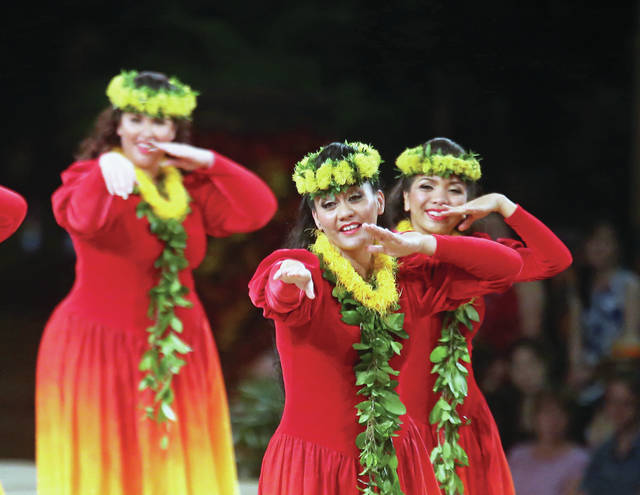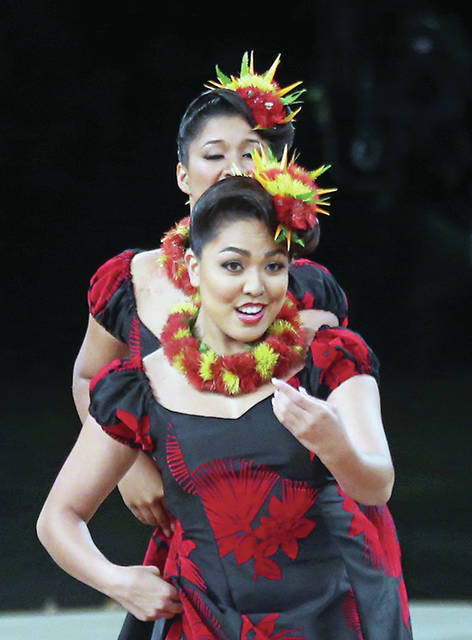HILO — As the annual Merrie Monarch Festival approaches, a collaboration of ancient hula tradition and current scientific research is working to help protect the ohia tree, one of Hawaii Island’s most precious resources.
HILO — As the annual Merrie Monarch Festival approaches, a collaboration of ancient hula tradition and current scientific research is working to help protect the ohia tree, one of Hawaii Island’s most precious resources.
The festival and its lush floral displays used to prominently feature the saturated greens, reds and yellows of ohia liko and lehua.
“Ohia is central to hula,” said Ulalia Woodside, executive director for The Nature Conservancy and a kumu hula. “It’s central to the Hawaiian culture. It’s central to the ecosystem and our forest habitats, as a home for our endangered forest birds, some of which are found nowhere else in the world, and as a source of clean water.”
Last year, ohia’s appearance at Merrie Monarch was muted as the hula community adapted to what many describe as the biggest threat the Hawaii Island ohia forest has seen: rapid ohia death, a fungal disease that has affected thousands of acres of trees to date.
The disease was first noticed in 2010 by residents of Puna, who saw ohia trees in their yards begin to brown and die within weeks. A fungus called Ceratocystis was identified as the culprit four years later, but by then, some Puna stands were showing mortality rates of 90 percent.
Between 2015 and 2016, more than 200,000 individual ohia trees died. Some estimates place the number as high as 300,000. More than 50,000 acres throughout Hawaii Island have been affected.
The disease has not spread to any other islands, however.
A state Department of Agriculture emergency quarantine on transporting ohia from Hawaii Island was in effect during last year’s festival (it has since been made permanent), but members of an ROD working group also were concerned about intraisland spread.
Hula halau traditionally go into the forest before Merrie Monarch to gather materials for lei and adornments, which are returned after the dancers’ performances as a way to continue honoring the aina.
“The dancer is able to receive these adornments, but the dancer gives back to the forest in terms of that reverence,” Woodside said. “These are critically important parts of our traditions, and when we gather these materials and dance with them, it is to remind us of that important reciprocal relationship we have.”
After a flurry of outreach efforts from the working group, the kumu decided they would not gather ohia as they had before. Merrie Monarch festival organizers and contest judges allowed other materials to be substituted for ohia.
“As outreach specialists, our job is really to convey the science to people, and the people’s feelings back to the resource managers,” said Christy Martin, public information officer for the Coordinating Group on Alien Pest Species and member of the working group. “These kumu know ohia, and they know ohia better than we do, and they will want to make their own decisions.”
“In not being able to (gather), the tradition does change,” Woodside said. “The tradition doesn’t die, but it does change the relationship.”
Still, she said, “The reaction that I had and what I heard from those who shared with me is that it was positive, and I think the continued awareness is important.”
“We consider the effort successful because of the networking that we would be able to do with the hula community and letting them decide how best to spread the word to the halau,” said Corie Yanger, outreach and education specialist for the University of Hawaii at Hilo College of Tropical Agriculture and Human Resources.
The working group also set up a booth to collect forest materials after each performance. On the final night of Merrie Monarch, a pua‘ena‘ena ceremony took place to burn the material and help “ask for the health and recovery and healing of our ohia forest,” Yanger said.
The ceremony will not take place this year, but outreach workers once again will be gathering materials after performances to return them to the forest, with members trained by kumu hula Kekuhi Kealiikanakaoleohaililani to follow protocol. There also will be stations at the island airports for leaving lei and kupe‘e behind.
“We will make sure the foliage gets taken care of respectfully,” Yanger said. “If they want to ho‘iho‘i or return the materials to the forest themselves, we have designated areas in the forest (which) have already been infected.”
She encouraged people who did decide to pick ohia this year to minimize the risk of disease spread.
“If folks are wanting to go and pick in the forest, they should just be sure they use (70 percent) rubbing alcohol to decontaminate their shoes before and after, and to be mindful,” Yanger said. “We know that the fungus gets in through wounds, so anything that breaks the wood is (dangerous).
The working group met twice with kumu during their Merrie Monarch organizational meetings, sharing informational packets and providing updates on research and disease spread.
“In the hula community, they want to know the latest of what’s going on,” Martin said. Outside of hula, she said, most people on other islands don’t know what ohia is because it is not as prevalent as it is on the Big Island.
“We’re in this for the long haul, and every day our scientists here in Hawaii and others that are familiar with this fungus are working diligently to prevent the spread,” Woodside said. “Working together as an entire community is very important for us.”
Email Ivy Ashe at iashe@hawaiitribune-herald.com.


